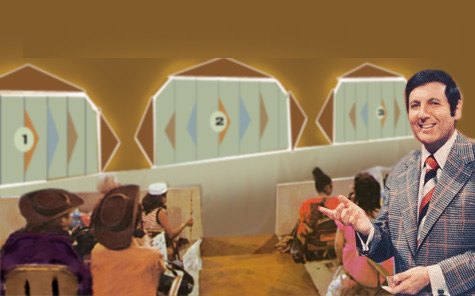
There’s a classic brain-teaser in the field of probability that goes like this:
Imagine that you’re on a television game show and the host presents you with three closed doors. Behind one of them, sits a sparkling, brand-new Lincoln Continental; behind the other two, are smelly old goats. The host implores you to pick a door, and you select door 1. Then, the host, who is well-aware of what’s going on behind the scenes, opens door 3, revealing one of the goats.
“Now,” he says, turning toward you, “do you want to keep door 1, or do you want to switch to door 2?”

Would you switch when given the choice or stick to your guns? If you haven’t heard this puzzle before, think about your answer carefully. It might just surprise you.
Go on, think about it. Continue reading only after you have thought of an answer.
Most people who attempt this problem reach the conclusion that the odds don’t change and it doesn’t matter whether you switch or stick to your original choice. The correct answer, however, is that you have a much better chance of winning if you switch. Sal Khan explains the math behind getting better odds of wining by switching in this video. You can even try it for yourself here.
This problem is know as the Monty Hall Problem. It is named after the host of a television gameshow “Let’s Make a Deal”. What’s interesting about this puzzle is the controversy it caused in the academic world. It started when Marilyn vos Savant, listed in the The Guinness Book of Records for highest recorded IQ, answered the puzzle in her column in response to a question from one of her readers. She wrote:
Yes; you should switch. The first door has a 1/3 chance of winning, but the second door has a 2/3 chance. Here’s a good way to visualize what happened. Suppose there are a million doors, and you pick door 1. Then the host, who knows what’s behind the doors and will always avoid the one with the prize, opens them all except door 777,777. You’d switch to that door pretty fast, wouldn’t you?
Her response provoked outrage from thousands of academics who insisted that she is wrong - the odds do not change:
I’m receiving thousands of letters, nearly all insisting that I’m wrong, including the Deputy Director of the Center for Defense Information and a Research Mathematical Statistician from the National Institutes of Health! Of the letters from the general public, 92% are against my answer, and and of the letters from universities, 65% are against my answer. Overall, nine out of ten readers completely disagree with my reply.
It’s just mind boggling that the puzzle evaded so many talented mathematicians and scientists who vehemently criticized Marilyn. Here’s what one PhD wrote:
You blew it, and you blew it big!
Since you seem to have difficulty grasping the basic principle at work here, I’ll explain. After the host reveals a goat, you now have a one-in-two chance of being correct. Whether you change your selection or not, the odds are the same. There is enough mathematical illiteracy in this country, and we don’t need the world’s highest IQ propagating more. Shame!
Scott Smith, Ph.D., University of Florida
From a true statistical standpoint, Marilyn is 100% correct. So why did so many experts have trouble wrapping their heads around this problem? According to Stanford professor Persi Diaconis:
“Our brains are just not wired to do probability problems very well, so I’m not surprised there were mistakes,”
So there’s a psychological side to the puzzle and, in reality, most contestants did not accept the switch and sticked to their initial choice:
Mr. Hall said he was not surprised at the experts’ insistence that the probability was 1 out of 2. “That’s the same assumption contestants would make on the show after I showed them there was nothing behind one door,” he said. “They’d think the odds on their door had now gone up to 1 in 2, so they hated to give up the door no matter how much money I offered. By opening that door we were applying pressure. We called it the Henry James treatment. It was ‘The Turn of the Screw.’”
Apparently for contestants and experts alike, the Monty Hall Problem causes cognitive dissonance which is the mental stress when an individual holds two or more contradictory beliefs or is presented with new information that conflicts with their existing beliefs:
When people are confronted with evidence that is “inconsistent with their beliefs” (ie. the odds of winning by switching doors being ⅔, instead of ½), they first respond by refuting the information, then band together with like-minded dissenters and champion their own hard-set opinion. This is precisely the mentality of vos Savant’s thousands of naysayers.
The way I see it: after one door is eliminated, most people believe that they have a 50/50 percent change of winning a brand new car or a smelly goat since there are only two doors left - the distribution is uniform. They believe in it so strongly that even after hearing correct explanations, that the distribution isn’t uniform, they refuse to believe in them because they conflict with their initial, more strongly held belief. They conveniently ignore the new information. The Monty Hall Problem is so counter-intuitive to our beliefs that Paul Erdos, one of the most brilliant mathematicians of the last century, rejected Marilyn’s correct solution and remained unconvinced until he was shown a computer simulation. According to Jeff Atwood, Paul Erdos finally realized his own limits:
Paul Erdos was brilliant, but even he realized his own limits when presented with the highly unintuitive Monty Hall problem. For his epitaph, he suggested, in his native Hungarian, “Végre nem butulok tovább”. This translates into English as “I’ve finally stopped getting dumber.”
If only the rest of us could be so lucky.
 What is Serverless Architecture? AWS Lambda Features (2020)
What is Serverless Architecture? AWS Lambda Features (2020)
Comments (1)
jeff_jo
This is an example of what I call a “simple” probability problem. I don’t mean that it is easy, I mean there are very few possibilities. With three doors, and two still closed, the answer can only be one of {1/6,1/3,1/2,2/3,5/6}. So it is quite possible to use the wrong logic, but still get the right answer.
Such “wrong logic” is almost always based on the assumption that some set of probabilities, from before you learned information, have to remain the same (relative to each other) after you take the information into account. Those who think switching doesn’t matter think the two closed doors were once equal, so they must remain equal. Most of the explanations that get the right result say that “picked right” and “picked wrong” started at 1/3 and 2/3, and also must remain the same.
Neither path of logic is correct. I’m not apologizing for the mathematicians who wrote in to say Marilyn was wrong, because I believe they sensed this. They erred by thinking her her result must also be wrong, so the other one must be right. When they should have reasoned out the solution based on all the information.
The way information gets used, is to eliminate the outcomes that become impossible based on it. When Monty Hall open a door, we learn that that door does not have the car. So we eliminate the outcomes that have the car there. But there is another way that door can get opened; if we picked the car and Monty chose that particular goat-door instead of the other goat-door. This should happen half of the time we picked the car.
Since Monty Hall will choose the door he did all of the time if we picked a goat, but only half of the time if we picked the car, the chances we picked a goat are now twice those that we picked the car. But if we know, for some reason, that Monty is biased and chooses that particular door with probability Q, then a simple application of conditional probability says the chances are Q/(1+Q) that we picked the car, and 1/(1+Q) that we picked a goat.